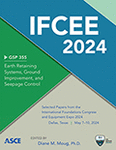The Relationship between Biopolymer Concentration and the Erodibility of Coarse-Grained Soil Comparing Tests Performed Using Different Boundary Conditions
Publication: IFCEE 2024
ABSTRACT
The objective of this paper is to examine the relationship between biopolymer concentration and the erodibility of coarse-grained soil. The erosion of soil by water (referred to as scour) is an important issue that affects many engineering structures such as earthen dams, levees, bridges, and embankments. Scour is one of leading causes of bridge failure; the cost of repairs due to scour has reported by the United States Department of Transportation to be very high. This gives rise to the need for an environmentally friendly solution to improving soil supporting these structures. Biopolymers, naturally occurring polymers that are found in living organisms, have been seen as a viable solution for ground improvement. Biopolymer treatment has been shown to enhance soil properties such as shear strength, compressive strength, and friction angle. Greater resistance to erosion is expected in samples treated with biopolymers. To confirm the erodibility of treated samples, this study will use the erosion function apparatus (EFA) to quantify the erosion rate of soil specimens with varying biopolymer concentrations. Xanthan gum was the biopolymer used to treat the soil specimens at 0.2%, and 0.4% concentration by weight of the soil. Well-graded Acco sand was used for this experiment. During the experiment, erosion rates were measured for each soil specimen in the EFA at the same velocity. Specimens were not allowed to cure for more than 1 h before testing and were prepared with the same water content and relative density. In this paper, comparisons are made between the tests performed in preliminary experiments in a different flume and those performed in the EFA.
Get full access to this chapter
View all available purchase options and get full access to this chapter.
REFERENCES
Akinola, A. I., T. M. Wynn-Thompson, C. G. Olgun, S. Mostaghimi, and M. J. Eick. “Fluvial Erosion Rate of Cohesive Streambanks Is Directly Related to the Difference in Soil and Water Temperatures.” Journal of Environmental Quality (2019): 48. 6. https://doi.org/10.2134/jeq2018.10.0385.
Briaud, J.-L., F. C. K. Ting, H.-C. Chen, R. Gudavalli, S. Perugu, and G. Wei. “SRICOS: Prediction of Scour Rate in Cohesive Soils at Bridge Piers.” Journal of Geotechnical and Geoenvironmental Engineering 125 (1999): 237–246.
Briaud, J.-L. “Erodibility of Fine Grained Soils and New Soil Test.” (2005). J. Geotech. Geoenviron. Eng.
Creed, B., S. Daniel, and A. Sherif. “Enhancing soil erodibility using biopolymer treatment” International Conference of Large Dams (2023).
Fatehi, H., D. E. L. Ong, J. Yu, and I. Chang. “Biopolymers as Green Binders for Soil Improvement in Geotechnical Applications: A Review.” Geosciences (2021): 11. 291. https://doi.org/10.3390/geosciences11070291.
Hoomehr, S., O. W. Parks, T. M. Wynn-Thompson, and M. J. Eick. “Effect of Water Temperature on Cohesive Streambank Erosion.” (2012). http://hdl.handle.net/10919/49663.
Kwon, Y.-M., S.-M. Ham, T.-H. Kwon, G.-C. Cho, and I. Chang. “Surface-erosion behaviour of biopolymer-treated soils assessed by EFA.” Geotechnique Letters 10 (2020): 106–112.
Kwon, Y.-M., M. Lee, I. Chang, and G. C. Cho. “Biopolymers for Erosion Mitigation of Soils Observed by Erosion Function Apparatus (EFA).” Geo-Congress 2023 (2023).
Ladd, R. S. “Preparing Test Specimens Using Undercompaction.” Geotechnical Testing Journal 1 (1978): 16–23.
Ni, J., G.-L. Hao, J. Chen, L. Ma, and X. Geng. “The Optimisation Analysis of Sand-Clay Mixtures Stabilised with Xanthan Gum Biopolymers.” Sustainability (2021): n. pag.
Parks, O. W. (2012). Effect of Water Temperature on Cohesive Streambank Erosion [Virginia Polytechnic Institute and State University].
Smith, D. J., M. Snead, and T. M. Thompson. (2022). Soil amended with organic matter increases fluvial erosion resistance of cohesive streambank soil. Journal of Geophysical Research: Biogeosciences, 127, https://doi.org/10.1029/2021JG006723.
Soldo, A. T., M. Miletić, and M. L. Auad. “Biopolymers as a sustainable solution for the enhancement of soil mechanical properties.” Scientific Reports 10 (2020): https://doi.org/10.1038/s41598-019-57135-x.
Information & Authors
Information
Published In
History
Published online: May 3, 2024
ASCE Technical Topics:
- Coarse-grained soils
- Engineering materials (by type)
- Environmental engineering
- Erosion
- Geology
- Geomechanics
- Geotechnical engineering
- Hydraulic engineering
- Hydraulics
- Materials engineering
- Pollution
- Polymer
- Scour
- Soil mechanics
- Soil pollution
- Soil properties
- Soil treatment
- Soils (by type)
- Synthetic materials
- Water and water resources
Authors
Metrics & Citations
Metrics
Citations
Download citation
If you have the appropriate software installed, you can download article citation data to the citation manager of your choice. Simply select your manager software from the list below and click Download.
